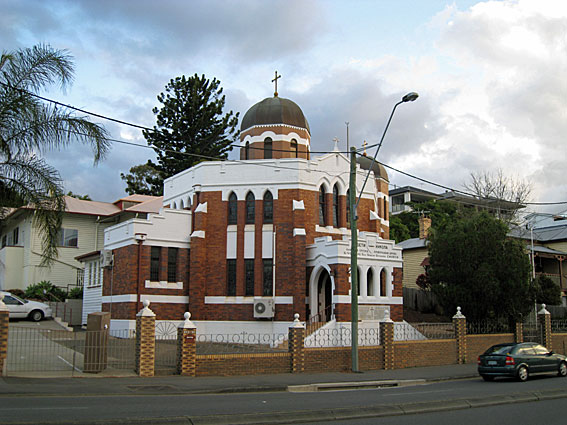
St Nicholas Free Serbian Orthodox Church
(formerly Congregational Church), South Brisbane
[Photograph by Geoffrey Cox (July 2011)]

St Nicholas Free Serbian Orthodox Church
(formerly Congregational Church), South Brisbane
[Photograph by Geoffrey Cox (July 2011)]
Historical and Technical Documentation by Geoffrey Cox
© OHTA 2011, 2020 (last updated February 2020)
The congregation of the South Brisbane Congregational Church first met in 1865 in the Mechanics Institute, Stanley Street, but they built a fine wooden building in Grey Street, which was opened in January 1867. It was dismantled following the 1893 floods, and rebuilt in Vulture Street. The congregation moved to the rebuilt building on Sunday 23 July 1893. The wooden church was gutted by fire on 16 October 1931, and the congregation repaired in the short term to the Hall for services. A new octagonal church, designed by T.B.F. Gargett of Brisbane, was opened and dedicated on 9 September 1933. The congregation ceased to worship at this location in 1975, and the building was sold to the Serbian Orthodox congregation.1
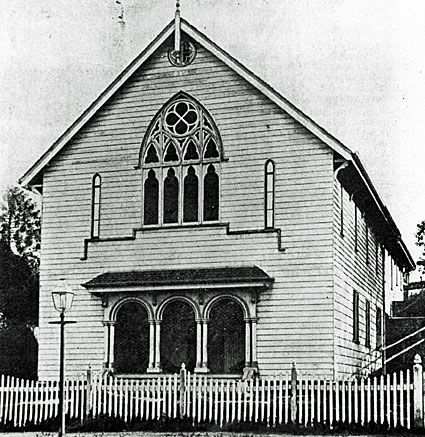
The Grey-Street Congregational Church, South Brisbane
[Photograph supplied by Dr Reg. Magee, 1989,
from John Oxley Library, State Library of Queensland]
First Organ (previous church).
A photograph of the interior of the old wooden church in Grey Street reveals that it contained a pipe organ.
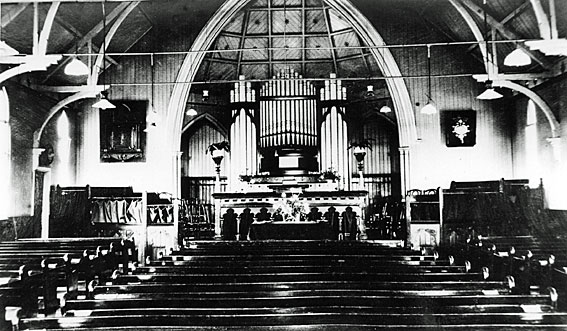
Interior of the first Congregational Church, South Brisbane
[Photograph supplied by Dr Reg. Magee, 1989,
from John Oxley Library, State Library of Queensland]
On the basis of visual similarities with other organs, the present author conjectured in a paper delivered at the 2007 OHTA conference in Maryborough, Qld, that this organ was built by B.B. Whitehouse & Co. of Brisbane.2 The casework shown in the above photograph is almost identical with that at the Wooloowin Methodist Church (April 1911). It is also very similar to the casework at All Hallows' Convent Chapel, Brisbane (originally at Holy Trinity Church, Mackay, October 1911) and at Holy Trinity Anglican Church, Woolloongabba (February 1912), except that the central rail is below the decorative braces on the towers in the latter two. The configuration of the façade pipes, comprising a central flat of 15 pipes with two angled towers of 5 pipes, is also similar to that at Wesley Church, Kangaroo Point (1903), although there are no posts or rail at Wesley.
The speculative attribution to the builder can now be confirmed by newspaper reports from the time when the organ was installed in December 1910. The first announcement came in The Brisbane Courier on 8 December:
New Pipe Organ.
A new pipe organ, built by Messrs. B. B. Whitehouse and Co., to the specification of Mr. George Sampson, is shortly to be installed in the South Brisbane Congregational Church, Vulture-street, and the opening will take the form of a recital by Mr. George Sampson, F.R.C.O., on the evening of December 19. The organ contains the following:- Great organ: Open diapason, 8ft.; dulciana, 8ft.; flute, 4ft.; Swell organ: Open diapason, 8ft., stop diapason, 8ft.; oboe, 8ft. Pedal organ: Bourdon, l6ft. Couplers: Swell to great, swell to pedal, great to pedal, octave coupler on swell, tremulant. The case, which is of very pretty design, is of pine, stained and polished, and the front pipes are aluminium painted. The cost was £340. The movement to obtain the organ was initiated by the organist (Mr. E. G. Schlencker) about four years ago.3
When the same details were repeated on 17 December, a photograph of the organ also appeared:
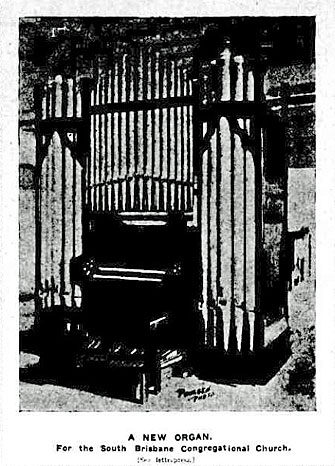
The new organ for the South Brisbane Congregational Church
[Photograph from The Brisbane Courier (17 December 1910), p. 12]
The South Brisbane specification was thus as follows:
| GREAT Open Diapason Dulciana Flute SWELL Open Diapason Stop Diapason Oboe PEDAL Bourdon COUPLERS Swell to Great Swell to Pedal Great to Pedal Swell Octave |
8 8 4 8 8 8 16 |
Swell tremulant
Mechanical action
Compass: not recorded.
This specification was almost identical with that of the organ built in the following year for Holy Trinity Anglican Church, Mackay, although the latter was originally one stop larger than the South Brisbane instrument.5 George Sampson's opening recital on 19 December 1910 was reported as follows:
The fine new pipe organ which has just been completed at the South Brisbane Congregational Church was utilised for the first time last evening, the occasion being marked by a congregation that filled the church to overflowing. An attractive recital was given by Mr. George Sampson, F.R.C.O., whose reputation as an organist was sufficient guarantee of a fine entertainment and who did justice to the instrument in every way, displaying to the full its admirable facilities for tone and expression. His programme included the "Grand Chorus in D" (Guilmant); "Postlude in E flat" (Wely); "Andante in D" (Silas); Organ Sonata, No 5" (Mendelssohn); "Gavotte in B flat (Handel); "Grand Offertoire in D" (Batiste); "Cradle Song " (Lange); "Little Dance" (Sampson) and "March Cornelius" (Mendelssohn). Particularly successful were the organist's renderings of the works of Mendelssohn, Handel, and Batiste. During the evening the minister of the church (the Rev. W. G. Sands) briefly sketched the history of the movement, which, commencing over 20 years ago had culminated in the erection of this beautiful organ. He made special reference to the part played by Messrs. E. G. Schlencker (organist) and A. C. Davidson (choir master). It had been originally intended, he said, to erect only a portion of the instrument but such had been the response to the appeal made that it had eventually been decided to secure the complete instrument, and they had done so at a cost of £340. Mr Sands expressed thanks on behalf of the church to Messrs Whitehouse and Co. (the builders), Mr. Sampson, F.R.C.O., who had been prominently connected with the supervising arrangements, and to the congregation. A collection was made in aid of the organ fund.4
The organ was presumably hand-blown originally, but it was 'fitted with a mechanical blower' in 1920.5 There are records of the organ having been tuned regularly by Whitehouse Bros from at least 1922 until late in 1931. The firm was paid £28 for 'cleaning, overhauling & repairing pipe organ' at this location in August 1930, and it was formally 're-opened' on Sunday 17 August.6 A recital was given in October that year by a visiting English organist, Mrs. G.A. Wakefield of Blackpool:
An enjoyable organ recital was given in the South Brisbane Congregational Church last Wednesday evening by Mrs. G. A. Wakefield, of Blackpool (England), before a large audience. The organ has recently undergone a thorough renovation by Messrs. Whitehouse Bros., at considerable cost to the church, and Mrs. Wakefield kindly consented to give a recital and assist in defraying the cost. After the opening hymn and prayer, the pastor, Rev. Ivan S. Stebbins, introduced the organist, who chose the following pieces: "Sonata No. 1" (Mendelssohn), "Andante in G" (Batesti), "Pastoral Op. 10" (Caesar Franck), "Two Communions" (Batiste), "Toccata and Fugue in D Minor" (Bach), and "Triumphal March" (Lemmens); she played as encores "Chant Triumphal" (Grey), and the first movement of the "Moonlight Sonata" (Beethoven). Mrs. Wakefield was assisted by Mr. G. A. Rowley, who sang "The Lord is My Light," and Mr. W. Cox-Horan, "Thanksgiving," and a duet by Messrs. Rowley and Cox-Horan, "Watchman, What of the Night."7
This organ was destroyed in the fire of October 1931, and Mr Darrel McMullen, who worked for Whitehouse Bros between 1927 and 1941, recalled that the fire had reduced it to 'a heap of lead'.8
Second Organ.
When the new octagonal church was opened in September 1933, it contained a new pneumatic-action organ that was built by Whitehouse Bros of Brisbane at a cost of £610.4.0.9 Special music was rendered by the choir under the direction of Mr Farris Chambers to mark the occasion. Mr E.G. Schlencker, who presided at the new organ, was described at the time as having been the organist of the church for 57 years.10
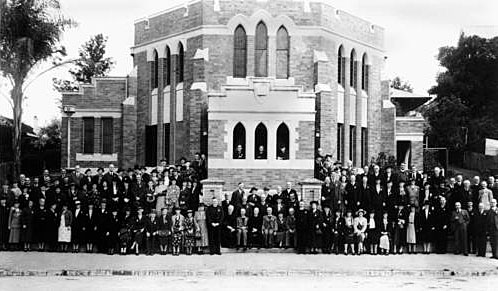
South Brisbane Congregational Church in 1939
[Photograph: John Oxley Library, State Library of Queensland]
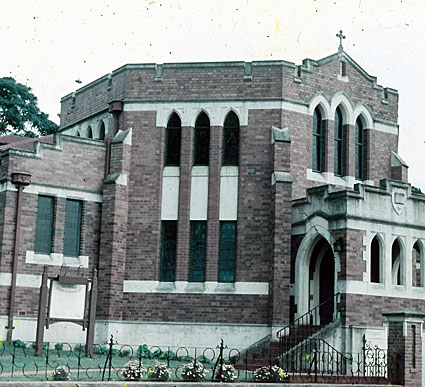
South Brisbane Congregational Church in 1959
[Photograph by Bryan Smith, supplied by David Vann (October 2013)]
The organ was typical of the standard pneumatic-action Whitehouse instruments of the time, using cone-pallet chests and featuring 'inclined-block type' stop tabs placed in a row above the upper manual. Indeed, the original specification was almost identical with that of the organ built in the same year for Scots Presbyterian Church, Clayfield.
The South Brisbane organ included the duplexing of the Swell Gamba 8ft as a Salicional 8ft on the Great, as was common on Whitehouse organs from this period onwards. But this instrument also included an unusual (possibly unique) borrowing of the Swell Gedact 8ft to provide a Flute 4ft on the Great. This was achieved with pneumatic action, and reportedly devised by Mr Joseph Whitehouse Snr. The Open Diapason 8ft was thus the only rank outside the Swell Box.11 The inclusion of a Labial Clarinet 8ft, rather than a genuine reed stop, had been a feature of the Whitehouse organ completed around a month earlier for Holy Rosary Catholic Church, Bundaberg. A Vox Humana 8ft stop was added to the Swell of the South Brisbane organ in December 1948 by Whitehouse Bros.12
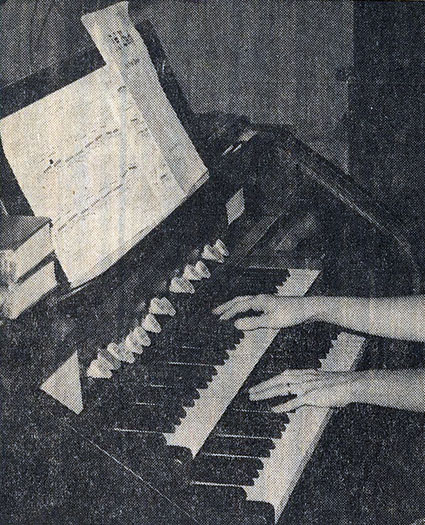
Console of the 1933 Whitehouse Bros organ
[The Sunday Mail (7 December 1975), p. 10]
| GREAT Open Diapason Salicional Flute SWELL Violin Diapason Gamba Gedact Labial Clarinet Vox Humana PEDAL Bourdon COUPLERS Swell to Great Swell to Pedal Great to Pedal Swell Super Swell to Great Super Swell to Great Sub |
8 8 4 8 8 8 8 8 16 |
A B A B [1948] |
Swell tremulant
Detached console
Compass: 61/30
Radiating concave pedalboard
Balanced swell pedal
Tubular-pneumatic action.13
Following the closure of the South Brisbane church in 1975 and the handing over of the building to the Serbian Orthodox congregation,14 the organ was removed in 1978 to storage at the Queen of Apostles Catholic Church, Stafford, initially awaiting a new church building there, but it was never installed.
The instrument was purchased in 2002 by John Brooks, a former employee of Whitehouse Bros who had returned from Victoria to live in Queensland at Coolum Beach. At the time of his death in January 2020, Brooks was restoring the instrument at his home in Coolum Beach, Qld with a view to finding it a new home. In supplying missing or damaged parts, he has been able to incorporate materials from the 1950 Whitehouse pneumatic console formerly at the Methodist Church, Chermside.15


Console and pipework of of the 1933 Whitehouse Bros organ,
during partial restoration at Coolum Beach
[Photos supplied by Stephen Brooks to Peter Robinson (January 2020)]
______________________________________________________________________________
1 W. Hiley and E.W. Hiley, A Century of Witness, 1865-1965: The Story of the First Hundred Years of the Life of South Brisbane Congregational Church (South Brisbane Congregational Church, c.1965), pp. 6-7, 9-10, 15; The Brisbane Courier (22 July 1893), p. 1; The Brisbane Courier (17 October 1931), p. 17; The Courier-Mail (11 September 1933), p. 11; The Sunday Mail (7 December 1975), p. 10.
2 Geoffrey Cox, 'Whitehouse Trackers: Reviewing the Opus List,' paper delivered at the 30th Annual Conference of OHTA, Maryborough, 2 October 2007.
3 The Brisbane Courier (8 December 1910), p. 6; repeated in The Brisbane Courier (17 December 1910), p. 13.
4 The Brisbane Courier (20 December 1910), p. 6.
5 W. Hiley & E.W. Hiley, op. cit., p. 12.
6 Whitehouse Bros Ledger (1922-1940), pp. 57-58, 484, 551; The Brisbane Courier (16 August 1930), p. 10.
7 The Brisbane Courier (11 October 1930), p. 8.
8 Personal communication to G. Cox from Dr Reg Magee, November 1989.
9 Whitehouse Bros Ledger (1922-1940), p. 287.
10 The Courier Mail (9 September 1933), p. 22; The Courier Mail (11 September 1933), p. 11.
11 Personal communication to G. Cox from John Brooks, September 2012.
12 Whitehouse Bros Ledger (1940-1954), p. 347.
13 Specification noted by G. Cox at South Brisbane, 1973, with additional borrowing details supplied by John Brooks, September 2012.
14 The Sunday Mail (7 December 1975), p. 10.
15 Personal communication to G. Cox from John Brooks, January 2004.